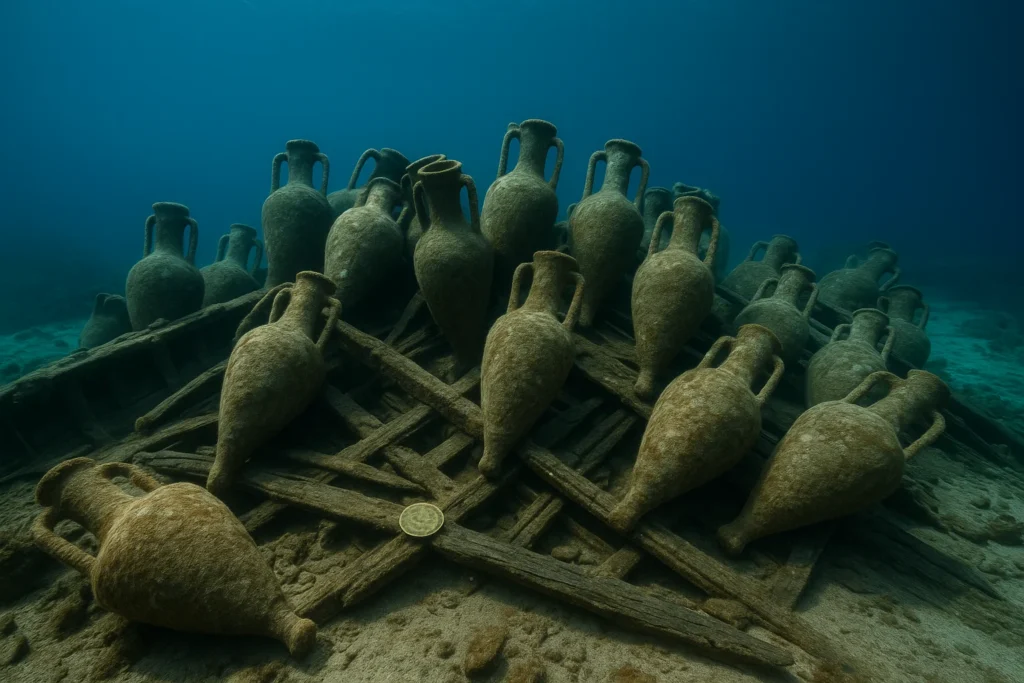Introduction: Beneath the Waves of History
The Mediterranean Sea, an ancient cradle of civilization, has long guarded a trove of secrets in its deep, silent embrace. For centuries, its waters served as the superhighway of the Roman Empire, a bustling nexus of trade and cultural exchange that connected far-flung provinces to the heart of Rome. Yet, for every voyage that reached its destination, countless others ended in tragedy, their stories lost to the depths. Now, a groundbreaking discovery off the coast of Sicily has brought one such epic story to the surface. A team of marine archaeologists has uncovered a nearly pristine Roman merchant vessel, a magnificent time capsule that has rested undisturbed for almost two millennia. This is not merely an artifact of the past; it is a living history, a direct line of communication with the vibrant, complex, and human world of the Roman Empire.
This extraordinary find was the result of a meticulously planned research expedition conducted by the University of Palermo’s Marine Archaeology Department. Utilizing state-of-the-art technology, including multibeam sonar and autonomous underwater vehicles (AUVs), the team was systematically mapping ancient trade routes when they detected an anomaly at a depth of 92 meters. Dr. Lucia Ferraro, the expedition’s chief archaeologist, recounted the thrilling moment when their remotely operated vehicle (ROV) descended and confirmed their suspicions. The dark abyss gave way to the undeniable silhouette of a ship’s hull, a sight that sent a ripple of excitement through the entire archaeological community. The wreck, now officially designated “Sicilia Wreck XII,” is poised to become one of the most important underwater archaeological sites ever discovered.
A Fateful Voyage: The Last Moments of a Roman Merchantman
Imagine a day in the Roman Empire around 138 CE. The vast empire, under the peaceful rule of Emperor Hadrian, was flourishing. In the bustling port of Carthage, a merchant ship was meticulously loaded with cargo destined for Italy. The vessel’s hold was packed with amphorae of rich olive oil from the sun-drenched groves of North Africa, fine wines from the vineyards of Hispania, and exotic spices gathered from the far reaches of the East. The crew, a diverse group of seasoned sailors and traders, was undoubtedly looking forward to a successful, profitable voyage across the “Mare Nostrum”—”Our Sea,” as the Romans proudly called the Mediterranean.
But the sea, despite its calming name, was as unforgiving then as it is now. As the ship sailed near the notoriously dangerous southern coast of Sicily, disaster struck. The calm, blue skies gave way to a sudden, ferocious storm. The wooden hull groaned under the relentless pounding of the waves, the cargo shifted violently, and the ship was driven onto an unseen reef. The crew fought valiantly against the sea’s fury, but their efforts were in vain. Within hours, the vessel and its crew were swallowed by the ocean, their story silenced, their final resting place lost to the unforgiving currents. For nearly 2,000 years, the ship lay in the cold, dark depths, a silent guardian of its own tragic history, until the advent of modern technology allowed us to listen to its story.
The Ship’s Structure: A Testament to Roman Engineering
The Sicilia Wreck XII is a masterpiece of Roman maritime technology, its construction revealing fascinating insights into ancient shipbuilding. The vessel, measuring approximately 22 meters in length and 7 meters at its widest point, was a medium-sized merchantman designed for maximum efficiency and durability. Its construction followed the “shell-first” method, a technique where the outer planks of the hull were assembled before the internal framing was installed. This method, common in Roman times, allowed for remarkable structural integrity.
- Hull and Planking: The ship’s hull was meticulously crafted from durable oak planks, joined together by sophisticated mortise-and-tenon joints—a technique that ensured the planks fit together seamlessly and held fast under the stresses of the open sea. Remnants of lead sheathing were found on the hull, a crucial detail revealing the Romans’ advanced understanding of protecting their ships from marine borers and other destructive organisms. The keel and framing were made from pine, a lighter wood, demonstrating a thoughtful and practical approach to naval architecture.
- Cargo and Bilge Systems: The vessel had an estimated cargo capacity of 150-200 tons, distributed across three distinct cargo holds. Archaeologists also identified a sophisticated bilge system, a network of channels and pumps designed to manage water that inevitably entered the hull, proving that Roman ships were far from primitive in their design.
- Navigation and Deck Features: The wreck also provided clues about the ship’s operational features. Remains of a wooden steering oar (gubernaculum), bronze fittings that may have been part of a windlass for raising the anchor, and possible mounting points for sails all paint a detailed picture of the ship’s functionality. According to Dr. Marco Vitruvio, a naval archaeologist on the project, the craftsmanship is “exceptional,” highlighting the advanced nature of Roman maritime engineering.
A Cargo of Stories: Unpacking the Ship’s Treasure Trove
The true significance of Sicilia Wreck XII lies in its astonishingly well-preserved cargo. This treasure trove of artifacts offers an unprecedented, detailed look into the economic heart of the Roman Empire. The vessel’s hold contained over 800 amphorae, each one a testament to the vast network of trade that sustained the empire. These “shipping containers of antiquity” represent at least six distinct types, each telling a different story:
- Dressel 20 Amphorae: The most numerous type found, these iconic vessels were the workhorses of the olive oil trade. Their characteristic ovoid shape and narrow neck were perfectly suited for transporting the famous olive oil of Baetica (modern-day Andalusia, Spain). Many of these jars still bear stamps and tituli picti—painted inscriptions that provide details about the producer, the contents, and the weight.
- Africana I Amphorae: Originating from North Africa, particularly modern Tunisia, these jars carried olive oil and the highly prized garum, a fermented fish sauce that was a staple of the Roman diet.
- Lamboglia 2 and Pelichet 47 Amphorae: These vessels carried wine, with the Lamboglia 2 originating from the Adriatic region and the Pelichet 47 being a rare find from Gaul. This diversity of wine amphorae illustrates the ship’s extensive journey and its role in supplying a wide range of goods to various markets.
- Luxury Goods: The cargo wasn’t limited to bulk goods. The wreck also yielded delicate glassware, including unguentaria (perfume bottles), and fine pottery known as Samian ware, some with the distinctive maker’s marks still visible. A nearly complete bronze oil lamp with intricate designs was also found, suggesting the ship carried luxury items intended for the wealthy Roman elite.
The Coins and the Chronicles of Daily Life
Among the most exciting finds was a small wooden chest containing 87 bronze and silver coins. This cache of coins provided the crucial chronological evidence needed to date the wreck with precision. The collection included Denarii of Emperor Hadrian (117–138 CE), as well as provincial coins from Alexandria and, most remarkably, a previously unknown issue from Syracuse. Numismatist Dr. Elena Aurelia explains, “The presence of a specific coin minted in 135 CE, which we have never seen before, is a game-changer. It could force us to rewrite parts of our understanding of Sicilian mints under Roman rule.”
Beyond the grand sweep of imperial trade, the wreck offers a poignant window into the daily lives of the sailors who called this ship home. The crew’s quarters yielded personal items like combs, toiletry items, and a small shrine with a figurine, possibly of Neptune, the Roman god of the sea. Evidence of food, including preserved olives, nuts, and salted fish, was also found, along with a small galley area with cooking pots, giving us a glimpse into the sailors’ diet and the rhythm of life at sea. A truly personal find was a wooden writing tablet with its wax still intact, holding the last thoughts or records of an individual whose life ended in this tragedy. Other personal items, such as gaming pieces, dice, and a sailor’s knife with a bone handle, paint a picture of a close-knit community enduring long voyages together.
A Forensic Reconstruction of a Tragedy
The meticulous analysis of the wreck has allowed archaeologists to piece together a compelling narrative of the ship’s final hours. Based on the cargo, the vessel was likely traveling from Carthage to Rome, with planned stops in Sicily. Sediment analysis points to unseasonal autumn weather as the likely cause of the disaster. The most striking piece of evidence is the way the amphorae are all piled dramatically on the port side, suggesting the ship listed violently before going down. According to Dr. Ferraro, this indicates the vessel was likely driven onto a submerged reef, where the hull was mortally damaged, leading to a swift sinking. “It must have happened very quickly,” she says. “There’s no evidence of any attempt to jettison the cargo, suggesting the crew had no time to save the ship.”
Conservation and Legacy: Protecting the Past for the Future
The exceptional state of preservation of both organic and inorganic materials presents a monumental challenge for conservationists. Waterlogged wood, leather, and textiles are extremely fragile and begin to disintegrate the moment they are exposed to oxygen. Professor Giovanni Marino, head of conservation, emphasizes the need for a careful and scientific approach. “We’re dealing with materials that have been perfectly preserved for 2,000 years. We have to be ready with the right conservation methods before we recover anything.”
To protect this invaluable site, the Italian Ministry of Culture has declared the wreck a “National Treasure.” A portion of the most significant artifacts will be carefully retrieved for detailed study and public display, while the majority of the wreck will remain on the seabed, preserved as an underwater archaeological park for future generations.
In a groundbreaking move to share this discovery with the world, the research team is creating a 3D virtual reality experience that will allow the public to “dive” the wreck from anywhere in the world. This virtual model, combined with an international exhibition tour of selected artifacts, will ensure that the story of the Sicilia Wreck XII reaches a global audience, transforming a scientific discovery into a shared cultural heritage.
A Window into a Lost World: The Ship’s Enduring Message
The Sicilia Wreck XII is more than a sunken vessel. It is a profound window into a lost world, offering unparalleled insights into Roman trade networks, shipbuilding technology, and the daily lives of its people. By studying the cargo, we learn about the economic ties that bound the empire together; by examining the ship’s construction, we gain a new appreciation for Roman engineering; and by looking at the personal belongings of the crew, we touch the lives of real people who lived and died two millennia ago. This wreck is a timeless reminder that history is not just a collection of dates and names, but a rich tapestry of human stories, waiting patiently beneath the waves to be discovered and told.




c9f90n